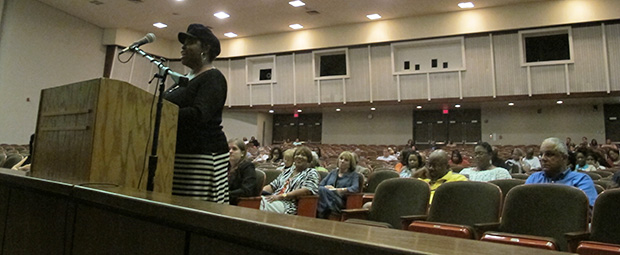Why Civil Rights Groups Fear ‘No Child’ Waivers Could Leave At-Risk Kids Behind

Kyle Stokes / StateImpact Indiana
Parents speak during a public hearing with state and district officials on intervention plans for Indianapolis' John Marshall High School in June 2012. Four out of five students in the school at the time were black.
It was one of No Child Left Behind‘s strictest requirements — one designed to close the nation’s persistent achievement gap between at-risk and more-privileged students:
Before federal education officials exempted Indiana from the national accountability law, schools tracked the performance of students in every socioeconomic and ethnic “subgroup” in their building. If any one subgroup was underperforming, the feds wouldn’t consider the school to have made “Adequate Yearly Progress.”
But after the feds granted Indiana’s waiver from this and other ‘No Child’ requirements, the state now tracks these groups collectively, not individually.
Across the nation, 41 states have now received NCLB waivers. To paraphrase this piece from the Associated Press, civil rights groups fear these waivers are dimming the spotlight on traditionally-underachieving student groups:
NCLB’s ‘Subgroups’
White students
African American students
Asian students
Native American students
Hispanic students
Limited English proficient students
Special education students
Students receiving free & reduced price lunch
The resulting patchwork of rules — from Miami to Seattle — has given states more freedom to implement plans to boost education but has allowed almost 2,300 schools to shed their label of seriously troubled, according to numbers compiled at the Campaign for High School Equity.
“It appears to us that waivers could lead to fewer students of color receiving the support they need,” said Rufina Hernandez, executive director for the Campaign for High School Equity.
Her coalition of education reformers, civil rights activists and policy analysts studied the 34 states and the District of Columbia that had received waivers from No Child Left Behind before April. (Another six states and a collection of individual districts in California have won waivers since then.)
The results show students who are at the highest risk of dropping out are often no longer tracked as carefully as they were before Education Secretary Arne Duncan began exempting states from some requirements if they promised to better prepare their students for college or careers.The Education Department had no immediate reaction to the study but [U.S. Secretary of Education Arne] Duncan has been vocal in calling for a rewrite of No Child Left Behind that would render his waivers moot.
That re-write, however, is stuck in a Congressional logjam — and not just because of D.C.’s partisan atmosphere. In this Washington Post op-ed, Duncan writes:
No Child Left Behind has given the country transparency about the progress of at-risk students. But its inflexible accountability provisions have become an obstacle to progress and have focused schools too much on a single test score. NCLB is six years overdue for an update, and nearly all agree that it should be replaced with a law that gives systems and educators greater freedom while continuing to fulfill the law’s original promise.
Others have argued a hyper-focus on the achievement gap is counterproductive to the debate over the future of No Child Left Behind.
But what about Indiana? School Matters‘ Steve Hinnefeld wrote last year that even though Indiana doesn’t track individual subgroups now, he says revisions state education officials filed at the time made clear they weren’t backing away from the goal of closing the achievement gap:
No, it won’t walk away from holding schools accountable for subgroups of students that weren’t supposed to be left behind: racial and ethnic minorities, economically disadvantaged students, special-needs students and English learners.
The state’s original waiver application, filed hurriedly in November, wasn’t at all clear about this. But the revised request, posted on the USDOE webpage, says schools will be expected to raise the performance of all subgroups to keep them on track to meeting state goals.
It’s not obvious how this will work. The traditional No Child Left Behind subgroups aren’t referenced in the new A-to-F school grading criteria approved last week by the State Board of Education. Instead the grading system relies on two “super subgroups,” the bottom 25 percent of students at each school and the top 75 percent. Schools get bonus points if either group shows “high growth” on test scores.
But the Indiana NCLB waiver document says schools will also be graded on the performance of each of the traditional subgroups. This is arguably a good thing – making it harder for schools to ignore achievement gaps if their overall scores are decent. But again, it remains to be seen how it will work.
